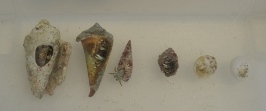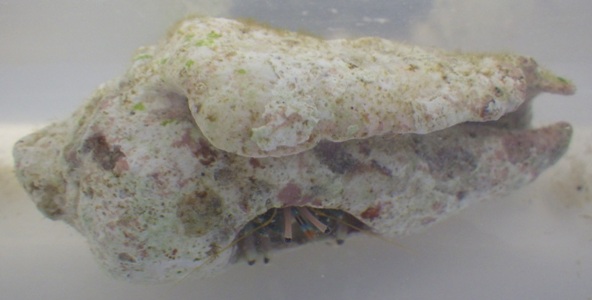Summary
Physical Description
Ecology
Symbionts & Parasites
Shell Selection
Adaptation
Life History & Behaviour
Anatomy & Physiology
Segmentation & Appendages
Evolution & Systematics
Biogeographic Distribution
Conservation & Threats
References & Links | Shell Selection
Almost all species of hermit crabs on the Great Barrier Reef inhabit in empty gastropod shells (Mather & Bennett 1993). Shells of the hermit crabs are known to have a range of benefits from the protection of the ventral surface to the avoidance of the predators and desiccation, while the unsuitable shell can limit its locomotion and growth. It appears that hermit crabs actively select shells by the shape, size and condition. Shih and Mok (2000) compared the shell selection by hermit crabs in field and in laboratory experiment and showed that the shell occupancy in the field does not necessarily reflect the preference under the ideal condition in the lab,probably because of the limited number of large shells available in the field.They also showed the differences in shell preferences by C. latens between those inhabiting in intertidal and subtidal (Shih and Mok 2000). They suggest that these differences are attributed to the differences in shell distribution as well as the competition with a sympatric species, Calcinus gaimardii, which is generally larger and occupy many of the available large shells of preferred gastropod species. On the other hand, the observation by Ismail (2010) indicates the intertidal zonation between C. latens and Calcinus signatus as well as the different shell utilization in overlapping habitats. The shells occupied by C. latens samples collected in Heron Island included Conus, Rhinocalvis, Nodilittorina, Turbo and Natica species; and the larger hermit crabs (Dardanus lagopodes and Dardanus megistos) tended to be found in Conus shells.

|
C. latens occupy gastropod shells of various shapes.
(Photo taken in Heron Island, September 2013)
|
In addition to the shell availability in the field, the attributes of the shell themselves such as the shell shape, size and damage are important factors of selection. The experiments by Ismail (2010) indicates that, although the shell quality can be more important as the selection factor, there is a threshold of the smallness of the shell size below which crabs choose a damaged but larger shell over the intact, small shell. Small hermit crabs especially tended to choose shells large enough for them to withdraw completely, which supposedly provides them with the full protection from the predators; in addition, this strategy can avoid the risk of not being able to find a larger shell when they grow bigger, although it accompanies the energetic cost to carry the large and heavy shell relative to the body size (Ismail 2010; Shih and Mok 2000). In addition, the irregular shape of the shell may also increase the risk of predation and being washed out by the surge (Bach & Hazlett 2009).Therefore, the intact shell of the suitable shape which is large enough to protect the whole body of the crab (but not too heavy) is likely to optimize the crab’s fitness; but such perfect shell is very limited on field. Thus the actual shell selection occurs by the trade-off between these preference factors and the availability of the shells. In Heron Island, some of the hermit crab samples were found in damaged shells, mostly of Conus species.
 
|
C. latens are sometimes found in broken Conus shells.
(Photo taken in Heron Island, September 2013)
|
|
|